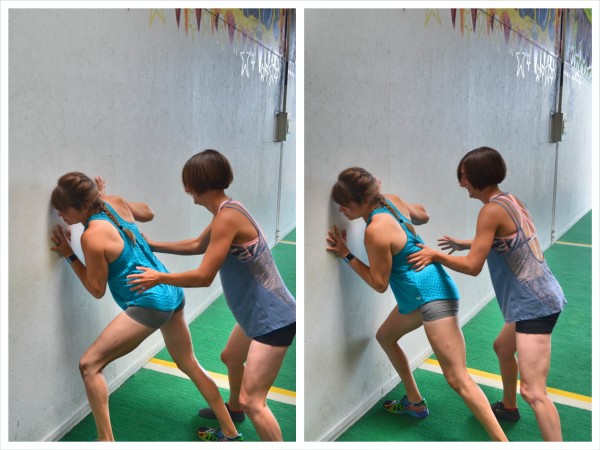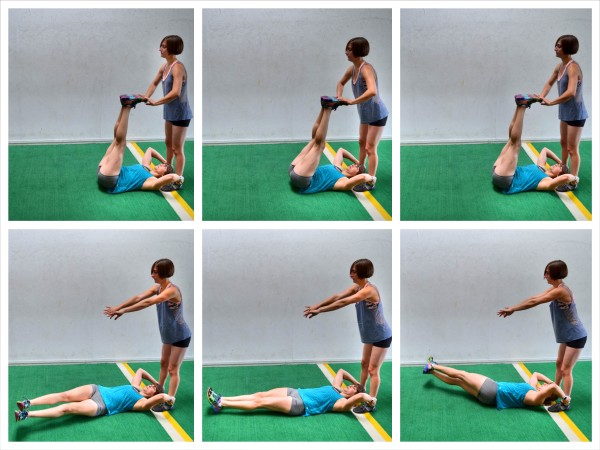WARM UP
Stretch and Roll Out:
Calves
Hamstrings
Quads
Groin
Hips/Glutes
Chest/Shoulders/Traps
WORKOUT
Perform 3-5 rounds of each of the circuits below. Perform the circuits in a you go, I go style with one partner completing all the moves back to back and then resting while the other partner goes. Rest 2-3 minutes between circuits.
CIRCUIT #1:
20 second Resisted Sprint
20 second Partner Reaction Lunges
20 second Partner Wall Pushes
CIRCUIT #2:
20 second Resisted Sprint
20 second Partner Drag
20 second Partner Leg Throws
COOL DOWN
Stretch and Roll Out:
Calves
Hamstrings
Quads
Groin
Hips/Glutes
Chest/Shoulders/Traps
NOTES:
By doing you go, I go, you can rest while your partner works. Make sure though that you work as hard as possible during the 20 seconds and move quickly from one exercise to another.
Do not rest between exercises.
EXERCISE DESCRIPTIONS:
For a video of all of these moves, click here.
Resisted Sprint – To do Resisted Sprints, wrap a band or towel around one partner’s hips or use a harness. The other partner will stand behind the partner sprinting, holding the ends of the band, towel or harness. The front partner will then begin to sprint. They will lean forward into the band and sprint, driving their knees up as they swing their arms from “cheek to cheek.” As they sprint against the band, their partner will pull back and slowly follow them. This isn’t about sprinting forward quickly, but about lots of quick knee drives as your partner allows you to slowly move forward. Move as quickly as you can using your arms and the rotation of your core as you quickly drive your knees. Do not round or hunch forward as you sprint. Also, do not start chopping vegetables with your arms. Drive your elbows back and swing your arms from about your cheek to your hip. Partners should also allow their partner to sprint forward slowly. Do not hold them in place or allow them to move forward too quickly. Beginners may need to slow down the knee drives and do more of a march.
Partner Reaction Lunges – To do the Partner Reaction Lunge, one partner will stand behind the other. The partner in back will “push” the front partner forward so that they have to react and catch themselves in a lunge. If you are the back partner, start by pushing your partner forward on their upper back. Push them hard enough that they have to step forward into a lunge and react, but not so hard they lose their balance. If you are the front partner, when you are pushed, step forward and sink into a lunge to decelerate and catch yourself from the push. Then drive back to standing, pushing off that front heel. Make sure to keep your chest up and core tight as you lunge. Also make sure you don’t go forward onto the ball of your foot or your toes. You want to land with your foot flat on the ground as you sink into the lunges. Push back up to standing and then have your partner push you again. This time lunge with the other leg to catch yourself. The “pushes” should be hard enough that the partner is challenged to react and catch themselves without being so hard that they completely lose their balance. The partner being pushed must also make sure to wait for the push. Do not lunge before your partner pushes you. The harder the push, the harder the move will be.

Partner Wall Pushes – To do the Partner Wall Push, one partner will stand facing the wall. They will set up fairly close to the wall with their feet in a staggered stance and their hands against the wall. They will then press into the wall as if trying to drive the wall back. Their arms should be bent as if they are pressing at the bottom of a push up and they should get close to the wall with their feet staggered back to help them push in. As they hold and drive hard into the wall, their partner will “push and pull” them to force them to stabilize and keep pressing into the wall. By pushing and pulling your partner, you are making sure they are driving into the wall as hard as they can and not simply leaning into the wall. If you are pushing into the wall, do not let your partner move you as they push and pull you. You want to engage your core and drive hard into the wall to help you stay still and balanced. If you are pushing and pulling your partner as they hold, make sure to put enough behind your pushes to force them to have to work, but don’t push them so hard that they keep losing their balance.

Partner Drag – To do Partner Drags, one partner will stand in front of the other with their back to their partner. The partner in front will step onto sliders, Valslides or towels. They can then cross their hands over their chest as their partner behind them reaches around to hold them under their arms. The front partner will then lean back into their partner as the back partner begins to walk/run backward. Both partners should brace their abs as they move and the back partner needs to make sure they don’t round forward as they drag their partner. Run/walk backward as quickly as possible dragging your partner.

Partner Leg Throws – To do Partner Leg Throws, one partner will lie on their back on the ground with their partner standing right behind their head. The partner on the ground will reach back and grab the standing partner’s ankles. The partner on the ground will then lift their legs up and back toward their partner behind them. Keep your legs straight and close together. The standing partner will then grab their feet and “throw” their partner’s legs toward the ground. They can throw them straight ahead or angled to one side or the other. Mix it up and make them react to the throw. Throw your partner’s legs hard enough that they have to fight to keep their heels up off the ground, but not so hard that they can’t control their legs and go crashing down. When your legs are throw, engage your abs and decelerate the throw right before your heels touch the ground. Then use your abs to raise your legs back up to your partner. Do not let your legs bend and make sure to keep your legs close together as your legs get thrown. Do not let your low back engage as you fight to keep your heels up off the ground or when you raise your legs back up. Remember, this is an advanced move. Beginners may even want to start with a variation of the Pelvic Tilt Progression before attempting this partner move.
